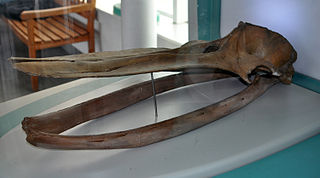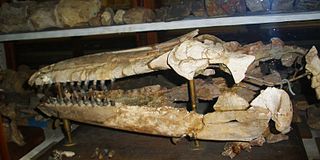 W
WThe Pisco Formation is a geologic formation located in Peru, on the southern coastal desert of Ica and Arequipa. The approximately 640 metres (2,100 ft) thick formation was deposited in the Pisco Basin, spanning an age from the Middle Miocene up to the Early Pleistocene, roughly from 15 to 2 Ma. The tuffaceous sandstones, diatomaceous siltstones, conglomerates and dolomites were deposited in a lagoonal to near-shore environment, in bays similar to other Pacific South American formations as the Bahía Inglesa and Coquimbo Formations of Chile.
 W
WPiscobalaena is an extinct genus of cetaceans, which lived from the Middle to Late Miocene epochs in Peru and Florida. Its fossils have been found in the Pisco Formation of Peru and the Bone Valley Formation of Florida. At least some individuals of this diminutive whale were preyed on by the shark C. megalodon.
 W
WPiscogavialis is an extinct genus of gryposuchine gavialid crocodylian. The only species yet known is P. jugaliperforatus. Fossils of Piscogavialis have been found from the Mio-Pliocene Pisco Formation of the Sacaco Basin in southern Peru in 1998. It is the first reptile known from the formation, which is otherwise notable for its high diversity of fossil vertebrates.
 W
WPiscophoca is an extinct genus of pinniped. The genus was named after the fossiliferous Pisco Formation in Peru, where the holotype was found. Other fossils of the genus were found in the Bahía Inglesa Formation of the Caldera Basin in Chile.
 W
WAcrophoca longirostris, sometimes called the swan-necked seal, is an extinct genus of Late Miocene pinniped. It was thought to have been the ancestor of the modern leopard seal, however it is now thought to be a species of monk seal.
 W
WAcrophyseter is a genus of extinct sperm whales that lived in the Late Miocene off the coast of Peru comprising two species: A. deinodon and A. robustus. It is part of a group of macroraptorial sperm whales which all shared several features for the purpose of hunting large prey, such as deeply-rooted and thick teeth. Acrophyseter measured 3.9–4.3 metres (13–14 ft), making it the smallest raptorial sperm whale. Because of its short pointed snout, and its strong curved front teeth, it probably fed on the large marine vertebrates of its time, such as seals and other whales.
 W
WAtocetus is an extinct genus of pontoporiid dolphin found in Miocene-age marine deposits in Peru and California.
 W
WBrachydelphis is a genus of pontoporiid known from the Late Miocene Pisco Formation of Peru and the Bahía Inglesa Formation of Chile.
 W
WHemisyntrachelus is an extinct genus of cetacean.
 W
WIncakujira is an extinct genus of rorqual from the Late Miocene Pisco Formation in western Peru.
 W
WLivyatan is an extinct genus of sperm whale containing one species: L. melvillei. The genus name was inspired by the biblical sea monster Leviathan, and the species name by Herman Melville, the author of the famous book Moby-Dick about a white bull sperm whale. It is mainly known from the Pisco Formation of Peru during the Tortonian stage of the Miocene epoch, about 9.9–8.9 million years ago (mya); however, isolated teeth from other locations such as Chile, Argentina, South Africa, and Australia implies that either it or a close relative survived into the Pliocene, around 5 mya, and was present throughout the Southern Hemisphere. It was a member of a group of hyper-predatory macroraptorial sperm whales and was likely an apex predator, preying on whales, seals, and so forth. Characteristic of raptorial sperm whales, Livyatan had functional, enamel-coated teeth on the upper and lower jaws, as well as several adaptations for hunting large prey.
 W
WMegalodon, meaning "big tooth", is an extinct species of shark that lived approximately 23 to 3.6 million years ago (mya), during the Early Miocene to the Pliocene. It was formerly thought to be a member of the family Lamnidae and a close relative of the great white shark. However, it is now classified into the extinct family Otodontidae, which diverged from the great white shark during the Early Cretaceous. Its genus placement is still debated, authors placing it in either Carcharocles, Megaselachus, Otodus, or Procarcharodon. This is because transitional fossils have been found showing that Megalodon is the final chronospecies of a lineage of giant sharks originally of the genus Otodus which evolved during the Paleocene.
 W
WOdobenocetops is an extinct genus of small toothed whale known from Peru and Chile. Its fossils are found in Neogene-aged marine strata dating from the Tortonian to the Zanclean. It had two tusks, and, in some fossils, one tusk was longer than the other.
 W
WSpheniscus muizoni is an extinct species of banded penguins that lived during the early Late Miocene in what is now Peru, South America. The species, the earliest member of the extant genus, was described in 2007 by Ursula B. Göhlich based on fossils found in the fossiliferous Pisco Formation of the Pisco Basin, southwestern Peru.
 W
WThalassocnus is an extinct genus of semiaquatic ground sloths from the Miocene and Pliocene of the Pacific South American coast. It is monotypic within the subfamily Thalassocninae. The five species—T. antiquus, T. natans, T. littoralis, T. carolomartini, and T. yuacensis—represent a chronospecies, a population gradually adapting to marine life in one direct lineage. They are the only known aquatic sloths. They have been found in the Pisco Formation of Peru and the Bahía Inglesa, Coquimbo, and Horcón formations of Chile. Thalassocninae has been placed in both the families Megatheriidae and Nothrotheriidae.